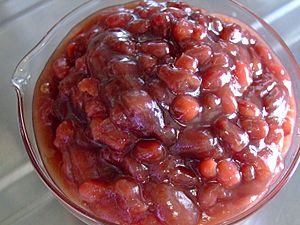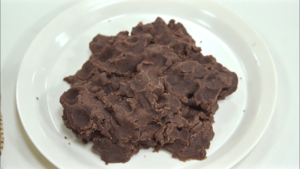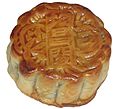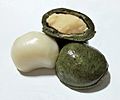Red bean paste facts for kids
 |
|
| Alternative names | Red bean jam, adzuki bean paste, anko |
|---|---|
| Type | Sweet paste |
| Region or state | East Asia |
| Main ingredients | Red beans, sugar or honey |
Red bean paste is a sweet paste made from red beans. People in East Asia use it in many different foods. It's also known as red bean jam, adzuki bean paste, or anko (a Japanese word).
To make it, red beans are boiled until they are soft. Then, they are mashed or ground into a paste. Sometimes, sugar or honey is added to make it sweet. The paste is usually dark red because of the bean skins. In Korea, people sometimes remove the skins before cooking to make a white paste. You can also remove the skins after cooking by pushing the paste through a sieve. This makes the red paste very smooth.
Contents
What is Red Bean Paste Called?
| Regional names | |||||||||||||||
|---|---|---|---|---|---|---|---|---|---|---|---|---|---|---|---|
| Chinese name | |||||||||||||||
| Traditional Chinese | 豆沙 / 紅豆沙 | ||||||||||||||
| Simplified Chinese | 豆沙 / 红豆沙 | ||||||||||||||
| Literal meaning | "Bean paste" / "red bean paste" | ||||||||||||||
|
|||||||||||||||
| Korean name | |||||||||||||||
| Hangul | 팥소 | ||||||||||||||
| Literal meaning | "Red bean filling" | ||||||||||||||
|
|||||||||||||||
| Japanese name | |||||||||||||||
| Kanji | 餡 / 小豆餡 | ||||||||||||||
| Kana | あん / あずきあん | ||||||||||||||
|
|||||||||||||||
In Japanese, there are a few names for red bean paste. The most common are an and anko. The word an can mean any sweet, mashed paste. But if you just say an, people usually think of red beans. Azukian means "red bean paste" specifically.
There are also other types of an. For example, shiroan is "white bean paste" made from white beans. Kurian is made from chestnuts.
In Chinese, dòushā (豆沙) usually means red bean paste. But if you want to be very clear, you can say hóngdòushā (Chinese: 紅豆沙), which means "red bean paste."
In Korean, pat (팥) means "adzuki bean." It's seen as different from kong (콩), which means "bean" and usually refers to soybeans. The word so (소) means "filling." So, patso (팥소) means "adzuki bean filling." This is usually an unsweetened, dark red paste.
If you add dan (단, meaning "sweet") to patso, you get danpat-so (단팥소). This is the sweetened red bean paste. Sometimes, it's just called danpat (단팥), meaning "sweet adzuki bean." There's also geopipat-so (거피팥소). This is a white paste made from red beans that have had their skins removed.
Different Kinds of Red Bean Paste
Red bean paste comes in different styles. These depend on how smooth, sweet, and colorful they are.
Chinese Styles
In Chinese cooking, these are common types:
- Some pastes are very smooth.
- Others might have small pieces of bean still in them.
Japanese Styles
In Japanese cuisine and sweets, these are popular:
- Tsubuan (粒餡): This paste has whole red beans boiled with sugar. The beans are not mashed.
- Tsubushian (潰し餡): The beans are mashed after they are boiled.
- Koshian (漉し餡): This is the most common type. The beans are pushed through a sieve to take out the skins. This makes it very smooth.
- Sarashian (晒し餡): The beans are dried first, then mixed with water again.
- Ogura-an (小倉餡): This is a mix of smooth koshian and whole-bean tsubuan.
Korean Styles
In Korean cuisine and sweets, these are often used:
- Patso (팥소): This is a dark-red paste. It's made by boiling and then mashing red beans. Sometimes, the skins are removed to make it smoother.
- Danpat (단팥) or danpat-so (단팥소): This is sweetened red bean paste. Honey or sugar is added when it's made. The skins are often removed to make it smooth.
- Geopipat-so (거피팥소): This is a white paste. It's made from red beans that have had their skins removed before boiling. Then, they are mashed.
How Red Bean Paste is Used
Red bean paste is a key ingredient in many delicious dishes across East Asia.
Chinese Dishes
Red bean paste is used in many Chinese foods, such as:
- Red bean soup (紅豆湯/紅豆沙): This is a sweet soup. It's often eaten as a dessert. Sometimes, it has tangyuan (rice balls) or lotus seeds in it.
- Tangyuan (湯圓): These are sticky rice balls. They are often filled with sweet things like red bean paste. They are boiled in water.
- Sweet zongzi (粽子): These are sticky rice and red bean paste wrapped in bamboo leaves. They are steamed or boiled.
- Mooncakes (月餅): These are baked pastries. They have a thin dough around a filling. Red bean paste is a common filling. People often eat them during the Mid-Autumn Festival.
- Bāozi (豆沙包): These are steamed buns. They can have many different fillings, including sweet red bean paste.
- Jiān dui (煎堆): These are fried pastries made from sticky rice flour. They are sometimes filled with red bean paste.
- Red bean cake (Chinese: 红豆糕): This is a type of cake with a sweet red bean paste filling.
- Red bean pancake
-
Chinese mooncake
Japanese Sweets
Red bean paste is used in many Japanese sweets:
- Anmitsu: A dessert with red bean paste, jelly cubes, fruit, and syrup.
- Anpan: A sweet bun filled with red bean paste.
- Daifuku: A small, round rice cake filled with red bean paste.
- Anko dango: Rice flour dumplings that can be topped or filled with red bean paste.
- Dorayaki: Two small pancakes with red bean paste in the middle.
- Imagawayaki: A pancake with red bean paste inside.
- Manjū: A steamed cake filled with red bean paste.
- Oshiruko or Zenzai: A sweet adzuki bean soup, often served with rice cake.
- Sakuramochi: A pink rice cake with red bean paste inside, wrapped in a pickled cherry blossom leaf.
- Taiyaki: A fish-shaped cake filled with red bean paste.
- Yōkan: A thick, jelly-like dessert made from red bean paste, agar, and sugar.
Korean Snacks and Desserts
Red bean paste is used in many Korean snacks and desserts:
- Baram-tteok: A type of tteok (rice cake) filled with white geopipat-so.
- Bungeo-ppang: A fish-shaped pastry filled with sweet danpat-so.
- Chalbori-ppang: Two small, sweet pancakes wrapped around sweet danpat-so.
- Chapssal doughnut: A sticky rice doughnut filled with sweet danpat-so.
- Gyeongdan: A rice ball cake filled with sweet danpat-so.
- Hodu-gwaja: A walnut-shaped cookie filled with sweet danpat-so.
- Hoppang: A warm, fluffy pastry filled with sweet danpat-so.
- Hwangnam-ppang: A pastry with a flower design on top, filled with sweet danpat-so.
- Jjinppang: A warm, fluffy pastry filled with unsweetened patso.
- Kkulppang: A sweet pastry covered with sweet danpat-so and corn syrup.
- Patbingsu: A type of shaved ice dessert.
- Songpyeon: A type of tteok with different fillings, including unsweetened patso, sweetened danpat-so, or white geopipat-so.
- Ttongppang: A fun, poo-shaped pastry filled with sweet danpat-so.
-
Jjinppang filled with patso
-
Danpat-doneot filled with danpat-so
-
Hodu-gwaja filled with danpat-so
-
Baram-tteok filled with geopipat-so
See also
 In Spanish: Anko para niños
In Spanish: Anko para niños












